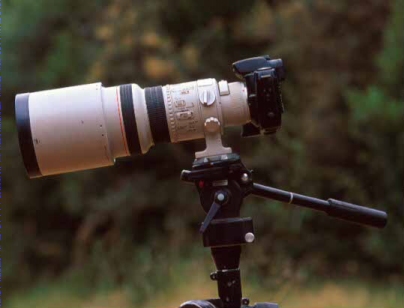Shooting Action
 Until a few years ago action photography of birds was a very difficult business indeed. Most of the pictures of birds in flight were taken with high speed flash triggered by an infra red beam device. Also, because it was necessary to know exactly where the subject would be flying to trip the beam, this pretty much restricted the use of all this paraphernalia to birds approaching a nest site.
Until a few years ago action photography of birds was a very difficult business indeed. Most of the pictures of birds in flight were taken with high speed flash triggered by an infra red beam device. Also, because it was necessary to know exactly where the subject would be flying to trip the beam, this pretty much restricted the use of all this paraphernalia to birds approaching a nest site.
To photograph, for example, a soaring eagle in natural light by manually trying to follow focus was extremely difficult. The degree of co-ordination required to pan smoothly and still keep the bird in focus was very demanding. In those days if I got two sharp pictures on a roll, I thought I was doing well. Apart from flight photography, shooting just about any action was more a miss than hit affair. Even trying to follow focus with a swimming duck would result in more 'throw outs' than 'keepers' when the film was processed. Fortunately technology has come to our rescue and almost all 35mm camera systems made today incorporate autofocus. From rather shaky beginnings just over 10 years ago when the manufacturers' earliest attempts would whirr and wander horribly, today's state of the art equipment means that a soaring eagle is no longer such a problem. When it comes to photographing that swimming duck, you can reckon on getting just about every picture sharp! The best of today's autofocus equipment features a motor inside the lens (or actually around the lens barrel) that can move the focussing elements incredibly quickly. This is coupled with a predictive program in the camera's mini computer that assesses the velocity of the subject and 'tells' the lens to track accordingly. Today's autofocus equipment tracks so fast that the limitation lies mainly with the photographer's ability to keep the autofocus sensing area in the viewfinder on a fast moving subject. Added to this, the very limited depth of field of a telephoto lens means that it is generally necessary to keep the autofocus sensing area on the head of the bird and this becomes quite a severe test of the photographer's co-ordination Tracking with such accuracy is almost impossible when hand holding a lens. Using a tripod helps a lot but most tripods sold for stills photography incorporate a pan/tilt or a ball and socket head that seldom pans smoothly enough to use with autofocus. Just a hint of jerkiness and it is very difficult to keep autofocus sensing area on the subject as it flies past. I have found that fluid action heads sold for video and cine work are much better. It is not necessary to go to the expense of purchasing a true fluid head designed for professional cine filming. The fluid action heads made for the amateur video market are fine. The model I use is the Manfrotto 136 and costs far less than a good quality ball head. Flight photography is also easier with lenses of 300mm or longer. The further away the subject, the slower you will need to pan to track accurately. Anyone who has been on an Okavango sunset cruise will know about this. Feeding the habituated Okavango fish eagles is the highlight for tourists and the bait, usually a tiger fish fillet skewered on a piece of bamboo stalk to make it float, is thrown just a few meters from the boat This is so close that you need to use a 50mm standard lens to frame the eagle. At such close range it is necessary to pan so fast to follow the eagle that the success rate is quite abysmal. I have found that the only way to get good fishing sequences of fish eagle is to hurl the bait about 30m from the boat and to shoot with a 300mm lens. Although the eagle is moving at the same speed, being much further away a slower pan is required to follow it and consequently there is more chance of success. Although autofocus has made it much easier to follow focus with a fast moving subject, to freeze the action a fast shutter speed is also required. For a soaring eagle, about 1/250th second is OK. If the eagle is coming in to land with rapid wing beats, you will need to use 1/1000th second or less. A wader foraging will also require a shutter speed of 1/1000th second or less. Because of the high shutter speeds, action photography is generally restricted to bright, sunny conditions if you wish to use a high definition film of 100ASA or less. Autofocus has undoubtedly opened up a whole new field of bird photography with potential to get exciting pictures of feeding, bathing, courtship and flight. For flight photography however, it works well only with the larger birds. I have used autofocus successfully with flight pictures of birds down to about dove size. Very small birds tend to fly too fast and too erratically to track with autofocus. Top | Previous | Next | Tips Home | Stock Images | Books | Tips | Gallery | FAQ's | Kruger Park | Contact Text and photographs © Nigel Dennis |